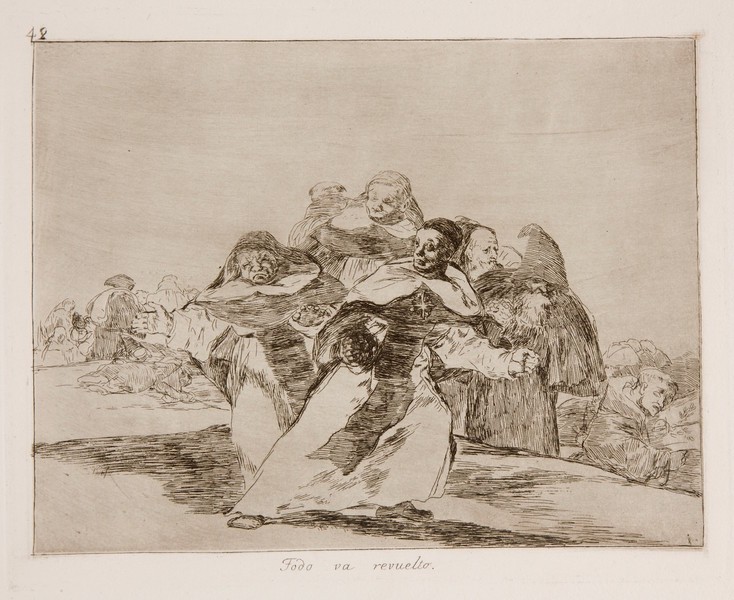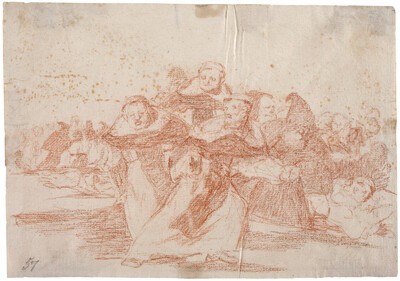- Cronología
- Ca. 1810 - 1815
- Dimensiones
- 178 x 220 mm
- Técnica y soporte
- Etching and burin
- Reconocimiento de la autoría de Goya
- Undisputed work
- Ficha: realización/revisión
- 13 Dec 2010 / 24 May 2023
- Inventario
- 225
See Sad presentiments of what must come to pass.
The title was handwritten on the print by Goya in the first and only series that is known to have been printed at the time the works were created, which the artist gave to his friend Agustín Ceán Bermúdez. Therefore, the title was etched into the plate at a later date and left unchanged as of the first edition of the Disasters of War printed by the San Fernando Royal Academy of Fine Arts in Madrid in 1863, after the printing of the series in the possession of Ceán Bermúdez.
There is a surviving preparatory drawing for this print which is housed in the Prado Museum.
Franciscan and Dominican monks are shown fleeing from the monastery from which they have been expelled. The confused looks on their faces express their indecision as to the best route to take. Indeed, each of the figures in the foreground indicates a different route to the others.
Goya left a good proportion of the surface of the plate empty, and has described the faces of the figures in great detail: in the majority of cases they are almost caricatures, a fact that has been interpreted as a criticism of the Church.
During the Spanish War of Independence, the Church positioned itself on the side of the Spanish people, but the ecclesiastical hierarchy acted in a more self-interested way as it saw a significant threat to the privileges they enjoyed in the ideas that the French represented. In the case of clergymen that did not belong to the upper echelons of this hierarchy, their position as allies of the people was more sincere: some even cast aside their habits in order to take up arms and fight alongside the guerrillas. As could be expected, this behaviour brought about some reprisals, leading to events such as that depicted in the print Everything is topsy-turvy.
The war shook Spanish society to its core, leading priests and monks to take arms to defend themselves in a way not appropriate to their station. This might be the message contained in the title of this print, although it may also make reference to the fact that the war had breached the stable comfort of religious life.
There may be a veiled message referring to the end of the Inquisition in the lower right-hand corner of the print, as pointed out by Jesusa Vega. On that section of the plate, Goya has etched a monk holding an emblem bearing a sword and an olive branch, symbols representing the Inquisition.
Miguel Gamborino (1760-1828) also produced a print (National Chalcography, Antonio Correa collection, Madrid) in 1813 that portrays the consequences of the intervention of the clergy in the Spanish War of Independence. It shows a group of Franciscan monks being shot by a French platoon on 18 January 1812.
Everything is topsy-turvy continues in the line of the previous print in the series, no. 41, They escape through the flames and also references the theme of the two following prints: no. 43, This too (También esto) and no. 44, I saw it (Yo lo vi), which depict figures fleeing a scene for various reasons.
The plate is stored in the National Chalcography (cat. 293).
-
Francisco de GoyaMuseo d'Arte ModernaLugano1996exhibition celebrated from September 22nd to November 17th.p. 159, cat. 42
-
Francisco Goya. Sein leben im spiegel der graphik. Fuendetodos 1746-1828 Bordeaux. 1746-1996Galerie KornfeldBern1996from November 21st 1996 to January 1997cat. 154
-
Francisco Goya. Capricci, follie e disastri della guerraSan Donato Milanese2000Opere grafiche della Fondazione Antonio Mazzottacat. 122
-
Goya. Opera graficaPinacoteca del Castello di San GiorgioLegnano2006exhibition celebrated from December 16th 2006 to April 1st 2007p. 72
-
Goya et la modernitéPinacothèque de ParisParís2013from October 11st 2013 to March 16th 2014cat. 81
-
Goya: Order and disorderMuseum of Fine ArtsBoston2014cat. 159
-
Goya, grabadorMadridBlass S.A.1918cat. 144
-
Goya engravings and lithographs, vol. I y II.OxfordBruno Cassirer1964cat. 162
-
Vie et ouvre de Francisco de GoyaParísOffice du livre1970cat. 1060
-
Catálogo de las estampas de Goya en la Biblioteca NacionalMadridMinisterio de Educación y Cultura, Biblioteca Nacional1996cat. 248
-
ParísPinacoteca de París2013p. 140
-
Goya: Order & DisorderBostonMuseum of Fine Arts Boston Publications2014pp. 244-245
-
Goya. In the Norton Simon MuseumPasadenaNorton Simon Museum2016pp. 114-151

